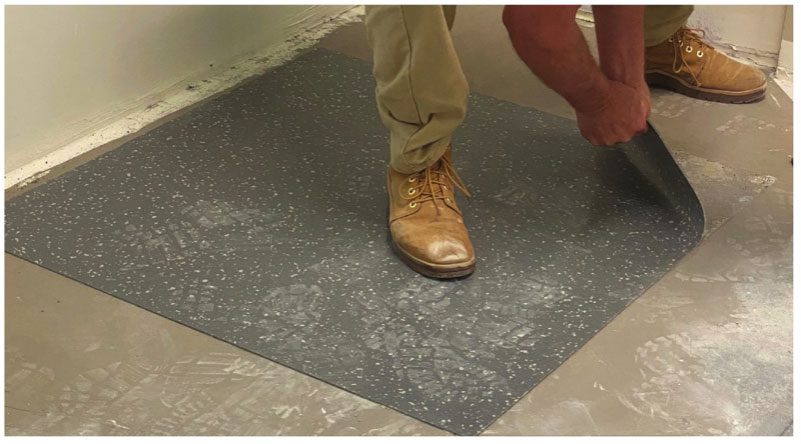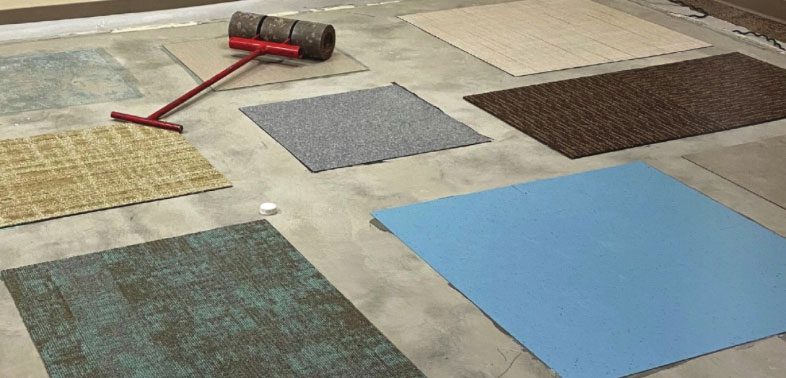Usually required – but are they being done? And are they being done correctly?
Many in the construction and floor covering installation industries are aware of moisture tests that occur before installing floor covering materials on concrete. Hopefully, more and more are becoming aware of the requirement to test for substrate surface absorption/porosity. Unfortunately, not as many are aware that almost all manufacturers either strongly recommend or even require adhesive bond tests before the complete installation of their products on a project. Thus this critical pre-installation evaluation often goes overlooked, or perhaps even worse, incorrectly carried out.
When in doubt, refer to the particular manufacturer’s literature for their procedure for bond tests. In the absence of any such instructions, there is ASTM F3311 -The Standard Practice for Mat Bond Evaluation of Performance and Compatibility for Resilient Flooring System Components Prior to Installation. This relatively new ASTM is the standard to guide installers on how to perform bond tests correctly, and it is imperative that the instructions within be carefully followed. If they are not, results that wrongly indicate an acceptable Mat Bond Evaluation can create much bigger issues when installing the full floorcovering system. Or results that failed may have only failed due to one or more key critical points not followed in ASTM F3311.
The ASTM F3311 practice is a qualitative and subjective evaluation and does not forecast the long-term performance of the bond and compatibility of the multi-layers of the flooring system. The Evaluation should include all aspects of the flooring system, including the concrete surface profile (CSP), surface preparation products such as underlayments and primers, surface moisture mitigation products, and the adhesive and floor covering materials. One needs to consider what the floorcovering product will be adhered to. Is it directly to the concrete surface? Or another layer between the concrete surface and the adhesive. All components of the flooring system should be evaluated in accordance with ASTM F3311 and in consideration of what each layer will be adhered to in the final flooring system.
Project teams may want to have the Mat Bond Evaluation completed weeks in advance of the floorcovering installation, with the intent of having plenty of time to correct or utilize other options if the Evaluation results fail. This, by default, puts the Mat Bond Evaluation in a non-climate-controlled environment and not in accordance with ASTM F3311.
But why do the Evaluation in the first place? Certainly, the adhesive manufacturers know if their products are compatible with the floor covering and subfloor surfaces; glance at any adhesive product datasheet, and the list is spelled out. But there are Jobsite conditions that necessitate the Evaluation be conducted. Let’s look at a few more common issues that may interfere with or skew an Evaluation result.
Dirt and dust. This issue may seem obvious, but one would be surprised how often it is overlooked: Dirt and dust. They are common bond breakers and must be thoroughly removed from the surface to which the flooring system is to be bonded to.
Is the surface absorptive or non-absorptive? This should be determined before the Mat Bond Evaluation is conducted and performed according to ASTM F710, which directs the installer to the manufacturers’ instructions and, absent those, to ASTM F3191. Some adhesives may be used over both surfaces but may require different spread rates and open times. This can significantly impact the Evaluation result if an adhesive that requires a porous surface is used over a non-porous surface and vice versa.
What is on the subfloor surface or in the concrete? One should assume that curing compounds and admixtures have been used with the concrete. A curing compound is a liquid substance added as a surface coating on freshly installed concrete. Curing compounds are used to reduce the loss of water or heat to create ideal conditions favorable to the concrete formation. It is extremely important to identify the specific curing compound product used before conducting ASTM F3311. These curing compounds typically fall into one of the following categories:
- Permanent curing compounds are usually acrylic or silicate-based and designed to remain on the substrate. Removal may not be required as long as they were installed in strict accordance with the curing compound manufacturer’s written recommendations, including removing any residual or ponded curing compound material.
- Self-dissipating curing compounds – are designed to break down under exposure to UV light. However, since there is no assurance that they have completely dissipated, before conducting ASTM F3311, the dissipating curing compounds should be completely removed by mechanical means. Curing compounds designed for exterior applications are often based on wax or petroleum emulsions and should never be used on a slab to receive floorcovering. If they are, they will need to be entirely removed by mechanical means before conducting ASTM F3311.
- Form release agents often called “bond breakers,” are products primarily designed for use with tilt-up construction and must be removed mechanically before conducting ASTM F3311.

There are many different types of admixtures that are used as an ingredient of a cementitious mixture and alter the properties of the concrete, including viscosity, permeability, set time, water requirements, and more. Look at a commercial project Div. 03 specifications and the list is numerous. For project specificity, look at the concrete mix design submittal and concrete contractor submittal for what is in that concrete and what has been applied to the concrete. These admixtures are added to the batch before or during mixing and become a permanent part of the hardened concrete. However, during concrete placement, it is possible that a residual amount of some admixture(s) used can migrate to the surface with the bleed water, dry on the surface, and may inhibit the bond performance of the adhesive or other products applied to the concrete.
Review the products being evaluated and follow the manufacturer’s specific requirements for acclimation, ambient conditions (including relative humidity, temperature, dew point), and the substrate surface temperature. Ambient conditions and substrate surface temperature are critical factors, and their parameters must be followed for an accurate Mat Bond Evaluation. For example, if the manufacturer’s installation instructions of the adhesive you are evaluating require that the substrate, flooring, and adhesive must be acclimated in an enclosed building with the HVAC operational and maintaining conditions between 60-95°F and 30-65% relative humidity for 72 hours before, during and after the installation, then those conditions must be met when conducting ASTM F3311.
For the record, ambient temperature, humidity and dew point, and the substrate surface temperature should all be documented and include the date, time, and location of the placement and Evaluation of each test area and include each flooring system layer that is being bonded together. Additional information that should be documented is substrate surface preparation required, copy or reference to the concrete mix design, and any products installed on the surface of concrete, whether removed or remaining. A lot of components to cover for a seemingly simple Evaluation, but all key for a successfully conducted ASTM F3311 with accurate and viable results.

